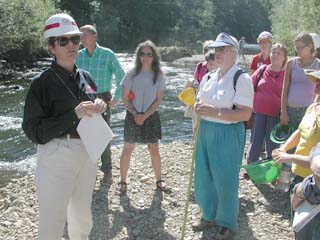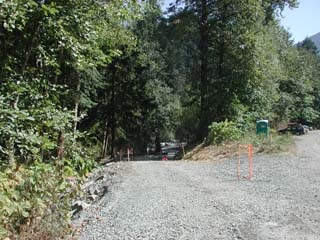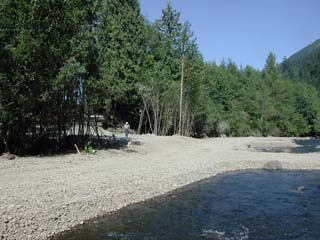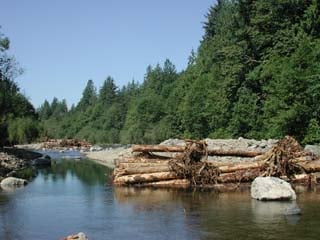Corps completes Phase I mitigation projects on the Green River (WA)
The Army Corps of Engineers (ACOE) recently completed phase I construction of engineered log jams and gravel addition projects on the Green River Headworks section. Members of the paddling community--represented by Friends of the Green River, American Whitewater, Mountaineers, Washington Recreational River Runners, PaddleTrails Canoe Club, University Kayak Club, Washington Kayak Club, and League of Northwest Whitewater Racers--have been working with the ACOE over the past several months to make sure the interests of those who enjoy recreational opportunities on the river are represented. Most of these organizations have participated in discussions with engineers on other regional projects to ensure safety not only for paddlers, but for children and adults who don't know how to read rivers and don't realize the dangers they can encounter on rivers, whether swimming, inner tubing or paddling. Paddlers first heard about these specific projects on the Green River last winter and had to work hard to get the ACOE to listen and consider paddler concerns and issues. Although members of the paddling community continue to have some concerns with the project, at least the ACOE has recently demonstrated a greater willingness to accept public input. Friends of the Green River has taken a leadership role in this project and has worked for many years to preserve and enhance recreational opportunities on the Green River, primarily by keeping water in the river which benefits both paddlers and endangered salmon.
Those who enjoy paddling opportunities on the Green Headworks section will notice several big changes. These changes were made as mitigation measures that were required for continued operation of Howard Hanson dam. In addition to affecting the natural flow regime, dams also disrupt flow of materials required by biota and essential for geomorphic processes. Gravel and wood are both important elements of river systems in the Pacific Northwest that are utilized by salmonids and other organisms.
The ACOE has had a long history of operations on the Green River for flood control purposes. Persistent floods affected the communities of Kent and Auburn and were a limitation to commercial development of land along the Lower Green and Duwamish Rivers. Led by Seattle attorney Howard Hanson, local chambers of commerce appealed to Congress for a flood control survey in 1928. Construction of Howard Hanson Dam was authorized in 1950 and completed in 1962 by the ACOE. An extensive system of levees further provides flood control for the Lower Green and Duwamish Rivers. The ACOE is the primary party involved in forcing the rivers into straight and narrow channels associated with these flood control efforts. Once Chinook salmon were listed as threatened on the Green River and most other Puget Sound rivers under the Federal Endangered Species Act, The ACOE had an obligation to consult with the federal agencies that manage fish and wildlife, US Fish and Wildlife Service and National Marine Fisheries Service, to determine what mitigation they must do for past, present, and future operations on the Green-Duwamish River. The ACOE is required to mitigate for gravel and wood that are trapped in the reservoir and unavailable for transport downstream. Mitigation measures include addition of 8000 cubic yards of gravel annually and construction of engineered log jams.
Although paddlers are accustomed to dealing with wood hazards on Pacific Northwest rivers, there are two primary concerns with a wood addition project on the Headworks section: this reach is a popular beginner training section for paddlers in the greater Seattle area, and many boaters can point to examples of projects that provide questionable benefits for fish but significant hazards for paddlers.
Changes that boaters will see at the Headworks put-in (near Tacoma's Water Treatment Building) include construction of a new road down to the river for the gravel addition project and two engineered log jams a short distance downstream. The new road may offer an opportunity for an improved put-in. As part of a settlement agreement Friends of the Green River signed with the City of Tacoma prior to construction of Pipeline 5 (the new water supply project for Tacoma and south King County), Tacoma had agreed to provide improved put-in access for the Headworks run. During negotiations earlier this spring, Tacoma suggested a site further downstream (away from the new treatment plant that is being constructed across the road from the Headworks put-in area) for "Homeland Security" reasons. A major problem with this alternative is paddlers would lose nearly 1/3 of the Headworks run. (By the way, if you have concerns with the way public utilities have implemented increased security measures at the expense of public access please contact your representatives in Congress).
The two engineered log jams have been constructed using new techniques, and are a short distance downstream from the put-in. It will be interesting to see how these log jams perform when the fall rains come. They have been designed to withstand a 100-year event and were constructed using river cobbles as ballast--they don't contain any cables that have created significant hazards for paddlers on other regional projects. Input from paddlers was incorporated into the final design, but all boaters should still exercise extreme caution when traveling downstream It appears that there will be a clear channel down river right at higher flows.
Included below are photos from a recent site visit where members of the paddling community were invited along with elected officials and agency staff to view the results of phase I construction. Phase II is scheduled to take place in August 2004 and will include construction of at least one additional log jam near the two constructed this year along with the annual gravel addition. Further engineered log jams are in the planning stages. These will be located on the Headworks reach near the railroad bridge. Paddlers are encouraged to get involved or stay informed and communicate their concerns or suggestions to representatives from local paddling clubs. If you wish to comment directly to the corps or to your congressional representative, let your paddling club reps who are working on these issues know. Presenting a united front will mean a clearer message, and a greater likelihood of being heard and making a difference.
If you would like to do a tour of the site with representatives from the environmental, recreational, and boating organizations listed above and the ACOE project manager of the Headworks section mitigation project, contact Pat Sumption, Friends of the Green River, 206-525-1708, or <patsump@juno.com>




